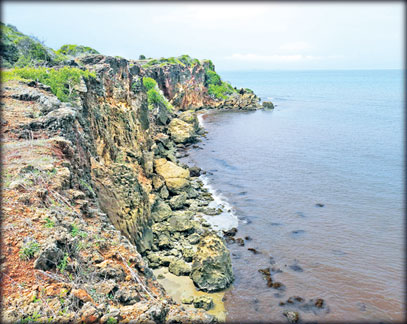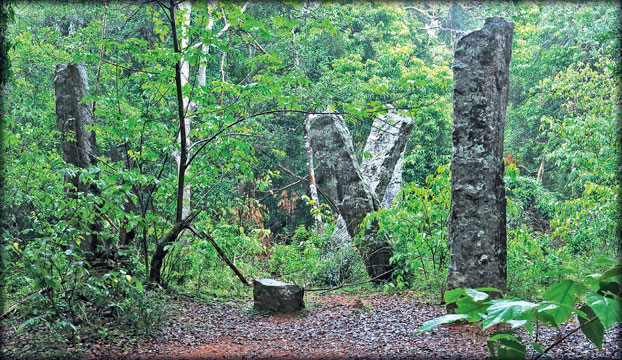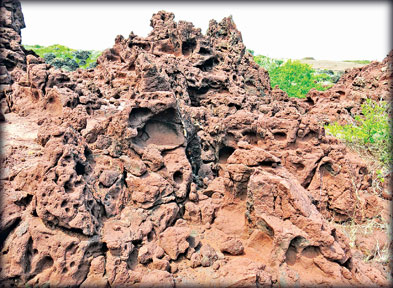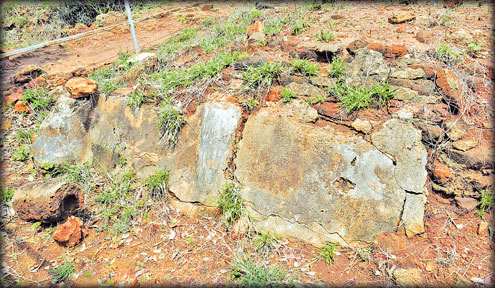 |
|
A view of Kudiramalai
Point |
Kudiramalai - a jewel of Wilpattu
By Mahil Wijesinghe
The historically significant Thambapanni or Kudiramalai is an ancient
sea port which lies in the western coast in the Wilpattu National Park.
On a beautiful day with perfect cotton candy clouds floating in the
clear blue sky, we had arrived in the heart of the Wilpattu National
Park, on the trail to the Kuveni Maligawa and Kudiramalai Point. This
was where princes and queens had left marks of their reign in their
palaces, most of which are crumbling today.
Our guide, Asela said there are many historically important places
throughout the Wilpattu jungle, while some of the ‘palaces’ have become
home to wild animals. The beautiful water-filled villus, once used by
queens, are now bathing ponds for crocodiles and water birds.
Leaving the Kokmote bungalow, we drove 16 kilometres on the sandy
track in the heart of the Wilpattu jungle when Asela told us to stop the
jeep as we were in the ancient site of the ‘Kuveni Maligawa’. As the
magnificent ruins emerged into view in the jungle, an ensemble of stone
pillars among them greeted us.
I could see the basic structure of the palace buried in the soil, yet
imposing, an example of Sri Lanka’s priceless and rich heritage.
There they were, exquisite stone pillars glistening in the morning
sun. Lying in ruins were stone pillars believed to have been part of an
edifice which belonged to Queen Kuveni; some of them standing, some
leaning on others or buried in the earth among the huge trees dotting
the jungle.
Vijaya and Kuveni
 |
|
Stone pillars of the
Kuveni Maligawa in the heart of the Wilpattu jungle |
Kuveni, a queen of the Yakka tribe is said to have lived here when
Prince Vijaya landed in Kudiramalai. It is believed that Kuveni and
Prince Vijaya started their reign from this region of Wilpattu.
The guide described the beautiful villu nearby, called Kali, as the
jewel of the Kuveni Maligawa. It looked like a huge basin filled with
crystal clear water and was used to store pure water for the queen’s
use.
We snaked through the jungle, crossing many villus and thick forest
area, until we reached the Puttalam - Mannar gravel road. After driving
a few kilometres on the muddy Mannar road, we branched off to the left
and reached the vicinity of Kudiramalai.
The small hills got closer, as the canopy of the forest spread itself
around us. In the middle of the green cover was a sea of blue in the
form of a villu. Asela described it as Maila Villu, the second largest
in Wilpattu. The coastal region was also home to the mighty
white-bellied sea eagle.
 |
|
A rocky formation of
red soil in the vicinity of Kudiramalai |
 |
|
The ruins of a horse
and man statue on Kudiramalai cliff |
The weather was better and the rays of the sun streamed out through
the clouds as we reached the Kudiramalai Point, on the western coast of
the Wilpattu National Park. The sea surrounding us was calm and in the
distant horizon, we saw the small island of Baththalangunduwa. Standing
on the edge of the cliff of Kudiramalai, I looked out and enjoyed the
panoramic view of the mighty Indian ocean where a steep slope formed
about 50 feet to the sea.
We walked around the site with Asela, who took us to every nook and
corner of Kudiramalai. The geological origins of Kudiramalai are
shrouded in mystery, but the general belief is that it is the site of an
ancient meteor strike. The reason behind this belief has been the unique
red soil and burnt rocks in the area. The soil contains high levels of
iron and other minerals, that give it a unique reddish hue.
Kudiramalai is also known as the Horse Mountain and is associated
with many historical theories. One legend says the Roman author, Pliny
recorded an account of a Roman tax collector who was blown off course
and landed in ‘Hippuros’ (Horse Mountain) in the monsoon season during
the time of Emperor Claudius (41-54 AD).
Ruled by a queen
The other legend speaks of Kudiramalai being ruled by a queen called
Alli Rani. Her warriors had been women and she had hated men. She was
believed to have been fond of pearls and it is said that during her
time, pearls were exported to Arab countries in return for Arab horses
and that business was carried out from this port. This may be perhaps
how the name of the area was derived and her palace is reputed to lie
buried under the cliff.
Walking further on the cliff, we could see the ruins of a cement
structure which was beyond recognition. Some believe these as the ruins
of a huge figure of a horse that had given the region its name.
It had
stood 35 feet tall, its front legs raised in the air and its rider
clinging to the reins. A lantern that hung from the statue was believed
to have guided ships into the port.
Further along the path to the shore, we could also see a cement tomb
where a Muslim saint is believed to be buried. Asela said that in the
past, there had been a fishing village in the bank of the Kudiramalai
cliff.
The sky started greying as we left the site and the sea greeted us.
However, today, Kudiramalai or Thambapanni stands in memory of Prince
Vijaya who is believed to be the founder of the Sinhala race.
 |
|
The view of the ocean
from the Kudiramalai Point |
|

